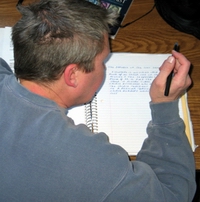Plagiarism/Academic Integrity Quiz
Because it deliberately includes poorly worded questions, this quiz is designed to provoke discussion; not to test knowledge.
- As long as I have his/her permission, it is OK to turn in a paper that someone else wrote for a previous class.
- Using a chart, graph, or photograph that someone else created requires a citation.
- I do not need to cite materials that are on the Internet.
- If I put something into my own words, I do not need to provide a citation for it.
- If I paraphrase or summarize a passage from a journal article, I am not guilty of plagiarism as long as I list the author in my bibliography.
- Words taken directly from another author's writing must include quotation marks around them.
- A unique two word phrase such as "pretzelized logic" requires a citation.
- In my paper, I write, "The Greeks knew that the earth was round long before Columbus set sail." I do not need to provide a citation for this passage because it is common knowledge.
- If, after reading Mary Heinking's review of The Librarian Who Measured the Earth, I write "Greeks before Eratosthenes knew that the Earth was round" I do not need to cite the source because this is common knowledge.
- Buying a paper from an on-line paper mill is considered to be plagiarism.
- I am expressing my own ideas or interpretations about the subject of my research paper. I do not need to cite a reference.
- An incorrect citation is a type of academic dishonesty.
- As long as I put quotation marks around the author's exact words or set them off in a block quote when I quote him/her and use a proper citation, there is absolutely no possibility that I could be guilty of academic dishonesty.
- If I take the advice of a peer editor or Writing Fellow, I am guilty of academic dishonesty.
- Changing one or two words in a long quote is a proper type of paraphrasing.
- In order to help you succeed in school, your parent goes to the library and does your research for you. This is an example of academic dishonesty.
- One of your classmates discovers a great web site that she/he thinks would be useful for your research and e-mails the URL to you. You use the web site as a source in your paper but you do not cite the fact that your friend found it for you. This is an example of plagiarism.
- If you find the exact information printed word-for-word on five or more different web sites, it is acceptable to use those exact words in your paper without citing a source.
- Submitting the same paper for two classes can be a form of academic dishonesty.
- You interview a teacher about the subject of your research. Then, using your notes, you re-write the teacher's thoughts into your own words. You must cite that interview as a reference in your paper.
- It is possible to commit "unintentional" plagiarism.
- At Schoolcraft College, plagiarism is against the student code of conduct and could result in failing a course.
Printer Friendly Version
Download a printer friendly copy of "Plagiarism/Academic Integrity Quiz."
